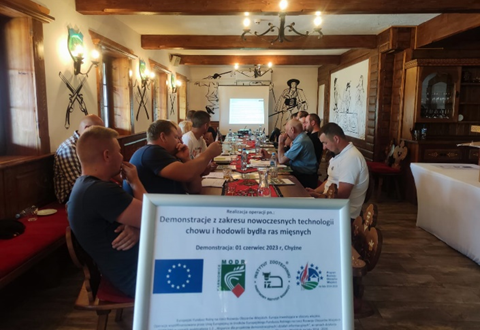A visit by farmers from the Małopolskie Voivodeship to a demonstration farm in Chyżne as part of sub-measure 1.2. “Support for demonstration projects and information activities” of the Rural Development Programme 2014–2020 for “Modern technologies for breeding and raising beef cattle”.
On 30 May this year, a group of 20 farmers from the Nowotarski and Tatrzański districts in the Małopolskie Voivodeship visited Jan Łyś’s farm, located in a beautiful location near the Tatra Mountains. The farm participates in a project to set up demonstration farms, covered by sub-measure 1.2. “Support for demonstration projects and information activities” and implemented as part of the Rural Development Programme 2014–2020 for “Modern technologies for breeding and raising beef cattle”. These activities are financed by the “Cooperation” programme, run by the Agency for Restructuring and Modernization of Agriculture. The direct implementers of the project are the National Research Institute of Animal Production and the voivodeship agricultural advisory centres, in this case the Małopolska Agricultural Advisory Centre in Karniowice, which, together with the Agricultural Advisory Centre in Brwinów, have formed a consortium for this purpose.
The demonstration at the farm of Jan Łyś concerns “Rational pasture management in the context of periodic droughts and feed shortages” It is one element of a series of demonstrations being carried out with the aim of setting up demonstration farms to be equipped with innovative equipment to support and facilitate precise and safe animal handling. Jan Łyś’s farm specializes in breeding Salers cattle – a breed of cattle of French origin that is rarely kept in Poland. The farm is run in the organic farming system and the animals, breeding, feeding and reproduction are supervised on a day-to-day basis by the head zootechnician Andrzej Majerski, who showed the first visit participants around the livestock buildings, showed them the pastures with their infrastructure and presented in detail the characteristics of the herd, the system of keeping animals and the well-equipped machine stock. The farm has about 20 ha of its own land, on which permanent grassland is maintained, and about 150 ha of leased land, also intended mainly for meadows and pastures. The areas belonging to the farm are so-called mountain less favoured areas. Despite this, the owner of the farm plans to expand the pasture area in the future. The pasture area is divided into approximately 10 paddocks of variable size, the paddocks are equipped with electric fencing and trough drinkers connected by pressure to a deep well. There are also water storage tanks in the housing area. The animals are housed in spacious, airy, free-stall buildings of light timber construction on shallow bedding – one barn for cows with calves and two overhead shelters for heifers, young stock and fattening stock. Surrounding the buildings are partially paved paddocks that the animals can use at any time. From May to October/November, the animals are on pasture around the clock, which is located in close proximity to the buildings. The herd comprises a total of around 150 purebred animals, of which 111 are under meat performance testing by the Polish Association of Beef Cattle Breeders and Producers. There are 40 suckler cows in the herd, of which 35 are under testing. The cows present in the herd are long-lived, the culling rate is low and mostly due to random cases and sterility resulting from the age of the animals. The Salers breed is resistant to adverse environmental conditions, the cows are good mothers with the highest milk production among beef cattle breeds, and they are long-lived animals that can be maintained under extensive feeding conditions. Jan Łyś’s herd is fed exclusively on roughage – pasture supplemented with hay in summer, haylage and meadow hay in winter. Among the good practices used by the farmer are the use of shelterbelts within the pastures used by the animals during the hot season, the alternating use of meadows and pastures, the very good welfare conditions, the selection of mated animals and the monitoring of newly born calves, including the disinfection and checking of the condition of the navels.
As part of the training, in further stages of the demonstration, it is planned to purchase and equip the farm with a modern restraining chute with livestock scales, a system of electric and portable mobile (rolling) fences to separate smaller spaces in the grazing paddocks, an isolated drinker for the newly built barn or pasture and a microchip system to monitor the body temperature of the animals and their movements within the buildings as well as in the pasture. Agata Karpowicz, Ph.D. Eng. from the National Research Institute of Animal Production’s Department of Cattle Breeding told the audience in detail about the purpose of the demonstration and its scope. She emphasized the importance of water retention measures within permanent grassland and the advisability of measuring pasture productivity. Together with the farm’s caretaker on behalf of the Małopolska Agricultural Advisory Centre, Krystyna Stękała, she also conducted the stationary portion of the lectures, which followed a break for coffee and cake and was held in a nearby regional inn owned by the farm’s owner. At the inn, visitors were able to taste products sourced and prepared from the farm’s Salers breed. During the lectures, participants in the first demonstration and training meeting were introduced to the characteristics of the individual cattle breeds, their predispositions for production, nutritional requirements, beef cattle housing systems, herd management and reproduction programmes, and the principles of safe work and animal handling. Breeders attending the meeting were keen to discuss the reproduction of their animals, mating dates, commercial crossbreeding and calf rearing. The training ended with a joint lunch for the organizers, the hosts and the visitors. The next visit to Jan Łyś’s farm is planned for August this year.



